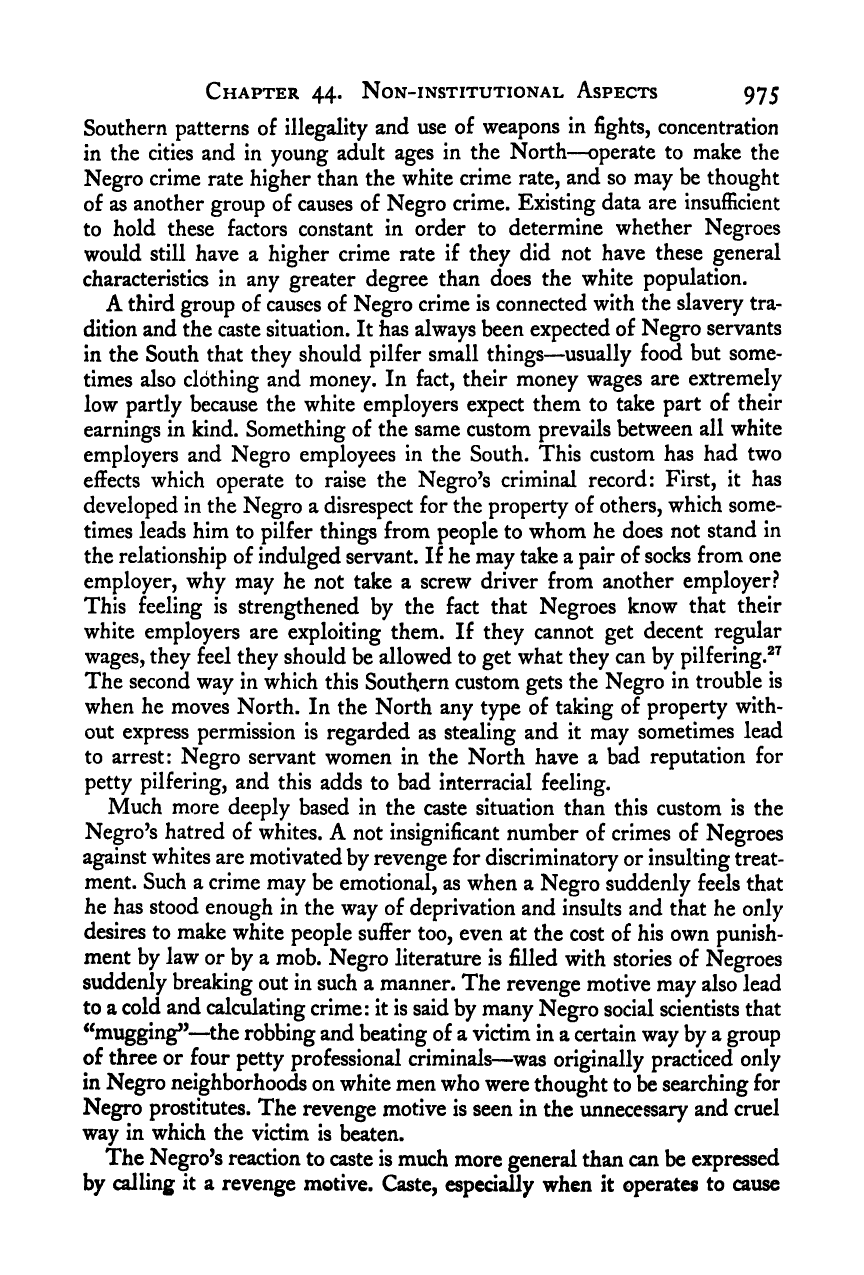Note: Gunnar Myrdal died in 1987, less than 70 years ago. Therefore, this work is protected by copyright, restricting your legal rights to reproduce it. However, you are welcome to view it on screen, as you do now. Read more about copyright.
Full resolution (TIFF) - On this page / på denna sida - X. The Negro Community - 44. Non-Institutional Aspects of the Negro Community - 2. Crime

<< prev. page << föreg. sida << >> nästa sida >> next page >>
Below is the raw OCR text
from the above scanned image.
Do you see an error? Proofread the page now!
Här nedan syns maskintolkade texten från faksimilbilden ovan.
Ser du något fel? Korrekturläs sidan nu!
This page has never been proofread. / Denna sida har aldrig korrekturlästs.
Chapter 44. Non-institutional Aspects 975
Southern patterns of illegality and use of weapons in fights, concentration
in the cities and in young adult ages in the North—operate to make the
Negro crime rate higher than the white crime rate, and so may be thought
of as another group of causes of Negro crime. Existing data are insufficient
to hold these factors constant in order to determine whether Negroes
would still have a higher crime rate if they did not have these general
characteristics in any greater degree than does the white population.
A third group of causes of Negro crime is connected with the slavery tra-
dition and the caste situation. It has always been expected of Negro servants
in the South that they should pilfer small things—usually food but some-
times also clothing and money. In fact, their money wages are extremely
low partly because the white employers expect them to take part of their
earnings in kind. Something of the same custom prevails between all white
employers and Negro employees in the South. This custom has had two
effects which operate to raise the Negro’s criminal record: First, it has
developed in the Negro a disrespect for the property of others, which some-
times leads him to pilfer things from people to whom he does not stand in
the relationship of indulged servant. If he may take a pair of socks from one
employer, why may he not take a screw driver from another employer?
This feeling is strengthened by the fact that Negroes know that their
white employers are exploiting them. If they cannot get decent regular
wages, they feel they should be allowed to get what they can by pilfering.^^
The second way in which this Southern custom gets the Negro in trouble is
when he moves North. In the North any type of taking of property with-
out express permission is regarded as stealing and it may sometimes lead
to arrest: Negro servant women in the North have a bad reputation for
petty pilfering, and this adds to bad interracial feeling.
Much more deeply based in the caste situation than this custom is the
Negro’s hatred of whites. A not insignificant number of crimes of Negroes
against whites are motivated by revenge for discriminatory or insulting treat-
ment. Such a crime may be emotional, as when a Negro suddenly feels that
he has stood enough in the way of deprivation and insults and that he only
desires to make white people suffer too, even at the cost of his own punish-
ment by law or by a mob. Negro literature is filled with stories of Negroes
suddenly breaking out in such a manner. The revenge motive may also lead
to a cold and calculating crime: it is said by many Negro social scientists that
^^mugging”—^the robbing and beating of a victim in a certain way by a group
of three or four petty professional criminals—was originally practiced only
in Negro neighborhoods on white men who were thought to be searching for
Negro prostitutes. The revenge motive is seen in the unnecessary and cruel
way in which the victim is beaten.
The Negro’s reaction to caste is much more general than can be expressed
by calling it a revenge motive. Caste, especially when it operates to cause
<< prev. page << föreg. sida << >> nästa sida >> next page >>